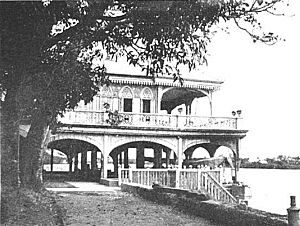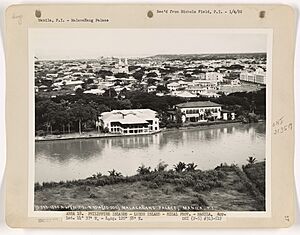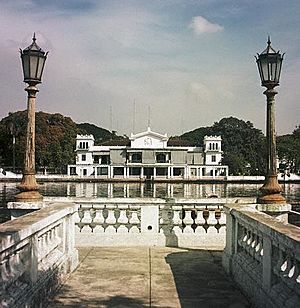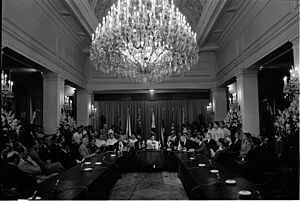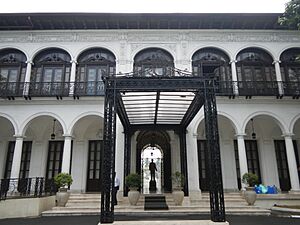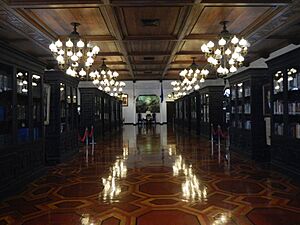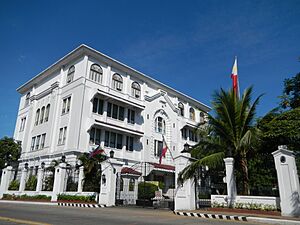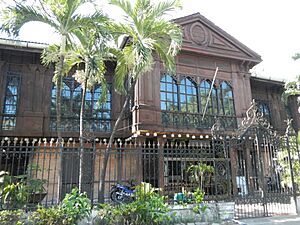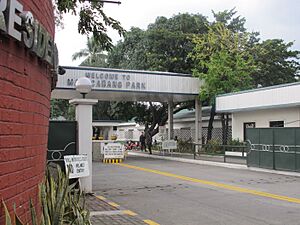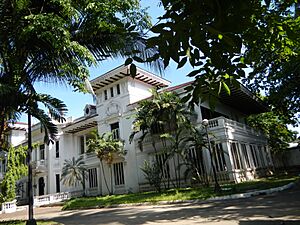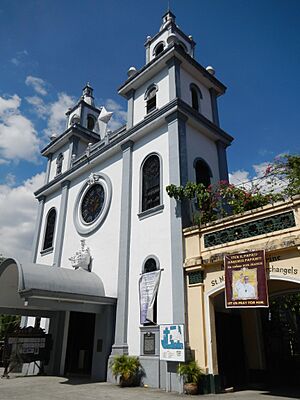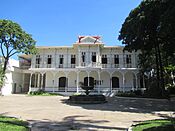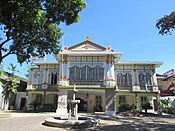Malacañang Palace facts for kids
Quick facts for kids Malacañan Palace |
|
|---|---|
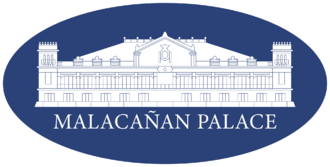 |
|
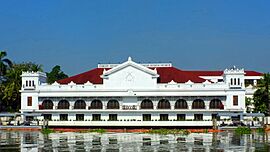
Malacañan Palace as viewed from the Pasig River
|
|
| Former names | Casa Rocha Governor's Mansion |
| Alternative names | Malacañang Palace Malacañang |
| General information | |
| Type | Residence and Office |
| Architectural style | Bahay na bato, Neoclassical |
| Location | San Miguel, Manila |
| Address | 4 Jose Laurel Street (formerly Calle conde de Avilés) |
| Country | Philippines |
| Coordinates | 14°35′38″N 120°59′40″E / 14.5939°N 120.9945°E |
| Current tenants | Bongbong Marcos President of the Philippines and the first family |
| Construction started | 1750 |
| Owner | Government of the Philippines |
| Technical details | |
| Floor area | 9,931 square metres |
|
National Historical Landmarks
|
|
| Official name: Malacanang Palace in the District of San Miguel in Manila | |
| Type: | Building |
| Designated: | May 6, 1998 |
| Legal basis: | Resolution No. 2, s. 1998 |
| Region: | National Capital Region |
| Marker date: | 1941 |
Malacañang Palace is the official home and main office of the president of the Philippines. It is located in the San Miguel district of Manila, along Jose Laurel Street. People often use the name Malacañang to refer to the president and their team. The palace complex has many buildings built in traditional Filipino and Neoclassical styles.
Since 1863, the palace has been home to many leaders. These include Spanish governors-general, American governors, and later, the presidents of the Philippines. The palace has been expanded and updated many times over the years. It was the only major government building in Manila to survive heavy bombing during World War II.
Contents
About the Name
What "Malacañang" Means
The word "Malacañán" likely means "place of the fisherman." This idea comes from old Spanish history books. The original name for the area might have been Mamalakáya-han. The Tagalog word mamalakáya means "fisherman," and the suffix -han means "place of." The Spanish later simplified it to Malacañán.
How the Name is Spelled
During the Spanish colonial period, the name was spelled Malacañang. When the Americans took over in 1898, they changed it to "Malacañan" for easier pronunciation. However, after President Ramon Magsaysay took office in 1953, the Philippine government changed it back to Malacañang.
Today, "Malacañan Palace" refers to the president's official home. "Malacañang" is used when talking about the president's office. This helps tell the two apart.
Palace History
Early Days
The palace started as a country house in 1750. It was built by a Spanish doctor named Don Luis José de la Rocha. He used it as a summer home with his wife. The house was made of stone and wood and was located along the Pasig River. It had gardens and a bath house.
In 1825, the government bought the property. It became the summer home for the Spanish governor-general.
Becoming the Official Residence
An earthquake on June 3, 1863, destroyed the governor-general's main residence in Intramuros. After that, Malacañang became the official seat of power. The first Spanish governor-general to live there was Rafaél de Echagüe y Bermingham. He found the house too small and added more rooms and buildings.
The palace continued to be the official home for colonial rulers after the United States took over in 1898. General Wesley Merritt was the first American governor to live there.
American and Commonwealth Eras
American governors-general continued to improve the palace. They bought more land and added new wings. The ground floor was raised to prevent flooding.
In 1935, the Commonwealth of the Philippines was established. Malacañang became the official residence of the Philippine president. President Manuel L. Quezon was the first Filipino to live there. He worked to control flooding around the palace.
Malacañang Palace was one of the few major government buildings in Manila that survived World War II bombings. During the war, it was used by the Japanese-installed President Jose P. Laurel.
Later Years and Renovations
When President Diosdado Macapagal moved into the palace, it needed many repairs. His wife, Eva Macapagal, started a project to make the grounds more beautiful.
President Ferdinand Marcos and his wife, Imelda Marcos, lived in the palace for a long time, from 1965 to 1986. During their time, the palace was greatly expanded and rebuilt between 1978 and 1979. The building was made stronger with concrete and steel. It was also made bullet-proof and had its own power supply.
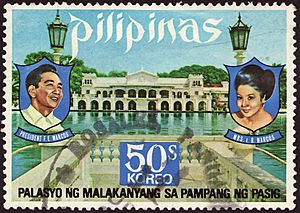
After the People Power Revolution in 1986, protesters entered the palace. The main palace was then opened to the public and became a museum for three years.
Later presidents, like Corazon Aquino and Fidel Ramos, chose to live in nearby houses instead of the main palace. President Gloria Macapagal Arroyo decided to live in the main palace again after she became president in 2001.
More recently, presidents like Benigno Aquino III, Rodrigo Duterte, and the current president, Bongbong Marcos, have chosen to live in Bahay Pangarap, a guesthouse within the complex.
Palace Buildings
Malacañang Palace (Main Building)
This is the most famous building in the complex. It has 10 main halls, some of which have been restored.
Entrance Hall
Official visitors enter through this hall. The floor and walls are made of Philippine marble. From here, you can go to the Grand Staircase or to Heroes Hall. The doors to the Grand Staircase show the Philippine story of Malakas (Strong) and Maganda (Beautiful).
Heroes Hall
This large room was originally for informal gatherings. It was renamed Heroes Hall by First Lady Eva Macapagal. She asked Guillermo Tolentino to create busts of national heroes.
The hall has large paintings that show important moments in Philippine history. These paintings cover events from ancient times to the present-day presidents.
Grand Staircase
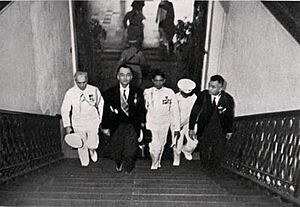
This staircase is made of fine Philippine hardwood and is covered in red carpet. It has been used by many leaders and visitors. There is a story that José Rizal's mother, Teodora Alonzo, climbed these stairs on her knees to ask for her son's life.
Paintings of Spanish explorers hang around the stairs. At the top, there is a famous painting called 'The Blood Compact' by Juan Luna.
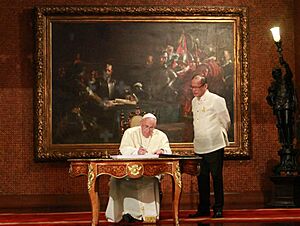
Reception Hall
Visitors gather here before events or before meeting the president. This room was once the largest in the palace. It features three large Czech chandeliers bought in 1937. These chandeliers were carefully hidden during World War II and reassembled afterward.
Portraits of all Philippine presidents hang on the walls of this hall.
Rizal Ceremonial Hall
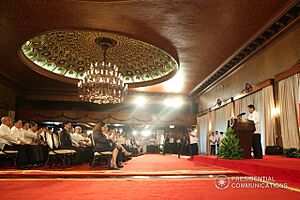
This room is the largest in the palace today. It is used for state dinners and large meetings. Three large wooden chandeliers light up the hall. These were carved in 1979 by Juan Flores.
New ambassadors present their credentials in this hall. This is a formal ceremony where they officially begin their work in the Philippines.
State Dining Room
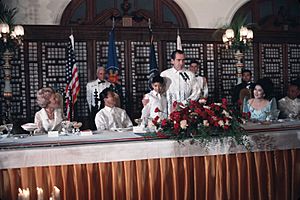
The State Dining Room is mainly used for Cabinet meetings. It can fit about fifty guests. Fine glassware and china are used for special occasions. Two large paintings decorate the room: a fiesta scene by Carlos "Botong" Francisco and an early rural scene by Fernando Amorsolo.
This room is also where Emilio Aguinaldo was held prisoner after his capture in 1901.
Presidential Study
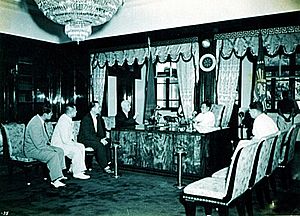
This is the president's official office. The presidential desk has been used by all presidents since the Commonwealth era. It was restored by President Ramos and again by President Arroyo.
Music Room
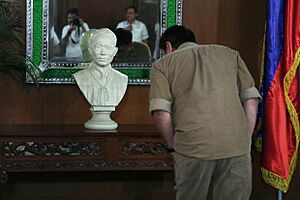
This room has changed its use over the years, from a bedroom to a library, and finally to the Music Room. First ladies often received visitors here. Sometimes, small concerts are held in this room.
Private Quarters
The private quarters are where the president and their family live. These rooms include bedrooms, living areas, and guest suites. The rooms are large and well-furnished.
Discothèque
A third floor was added in 1979, which includes a roof garden and a discothèque. This disco is located above the president's bedroom. It has special lights and music equipment. It has not been used since 1986. During the Macapagal-Arroyo administration, it was changed into a music hall.
Paranormal Activity
Some people have reported seeing or feeling strange things in the palace. One story is about the ghost of President Quezon's valet, who sometimes helps guests.
Kalayaan Hall
The old Executive Building is now called Kalayaan Hall. It is the oldest structure in the palace complex. It was built in 1921. It was renamed Kalayaan Hall in 1986 to remember the People Power Revolution.
Presidential Museum and Library
The Presidential Museum and Library is located in Kalayaan Hall. It holds items and memories of all the presidents of the Philippines. You can see clothing, personal items, gifts, and documents from former presidents. It also has artwork and furniture from the palace.
New Executive Building
This building was once the office of San Miguel Corporation. The government bought it to use as additional office space. It was rebuilt in 1989 under President Corazon Aquino. It now houses offices like the Presidential Spokesperson's office and the Malacañang Press Briefing Room.
Across the street is a Spanish colonial house called Bahay Ugnayan. It used to be the office for public complaints.
Mabini Hall
Mabini Hall is a large building to the left when you enter Gate 4. It started as the Budget Building in 1936. After World War II, it temporarily housed the Supreme Court. It now holds offices for the executive secretary and other presidential staff. After a fire in 1992, it was rebuilt and renamed Mabini Hall after Apolinario Mabini.
Bonifacio Hall
The Premier Guest House, now called Bonifacio Hall, was originally built as servants' quarters. It was remodeled in 1975. The Marcos family lived here while the main palace was being rebuilt. President Corazon Aquino used this building as her office from 1986 to 1992.
In 2003, President Gloria Macapagal Arroyo renamed it Bonifacio Hall to honor Andrés Bonifacio.
Malacañang Park and Bahay Pangulo
Malacañang Park is across the river from the main palace. It has a Recreation Hall, a small golf course, and a guesthouse called Bahay Pangarap (Dream House). The park was created in 1936-1937.
Bahay Pangarap has served as the official residence for presidents since Benigno Aquino III. The current president, Bongbong Marcos, has lived there since June 30, 2022.
Other Buildings
The palace complex also includes other facilities.
- Laperal Mansion or the Arlegui Guest House is a large mansion near the palace. It was once the home of the speaker of the National Assembly during World War II. After the war, it became a guesthouse. Presidents Corazon Aquino and Fidel Ramos chose to live here instead of the main palace.
- Goldenberg Mansion
- Teus Mansion
- Presidential Broadcast Staff Radio Television Malacañang (PBS-RTVM) is a government group that covers and documents all the president's activities for news and video archives.
- San Miguel Church is a church near the palace. It was built in 1603 and moved to its current spot in 1783. It was declared a national shrine in 1986.
Gardens
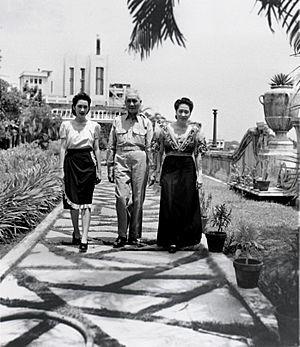
The palace grounds have beautiful gardens with tropical plants and old acacia trees. There are also balete trees. The wide lawns and green spaces show how Manila might have looked long ago.
The public garden, called 'Freedom Park,' has statues that represent the four freedoms: religion, expression, want, and fear. An Art Deco fountain from the 1930s still flows near the main palace entrance.
At the main entrance, there is a large balete tree. It is said to be home to a kapre, a mythical creature. During Christmas, it is decorated with colorful star lanterns.
Security
The Presidential Security Command and the Philippine National Police protect the palace.
Historical Marker
The National Historical Commission of the Philippines placed a marker at Malacañang Palace in 1941. It tells about the palace's history.
| MALACAÑANG PALACE |
|---|
| THIS WAS THE FORMER SITE OF SUMMER RESIDENCE PURCHASED IN 1802 FROM LUIS ROCHA BY COLONEL MIGUEL JOSE FORMENTO, WHOSE TESTAMENTARY-EXECUTORS SOLD IT TO THE SPANISH GOVERNMENT IN 1825. BY ROYAL DECREES OF 1847, THIS PROPERTY WAS SET ASIDE AS THE SUMMER RESIDENCE OF THE GOVERNOR GENERAL. THE PALACE IN INTRAMUROS HAVING BEEN DESTROYED BY THE EARTHQUAKE OF June 3, 1863, THE GOVERNOR GENERAL MOVED TO THIS PLACE, THEN KNOWN AS THE POSESION DE MALACAÑAN. THIS BUILDING WAS RECONSTRUCTED, NEW LOTS WERE PURCHASED, OLD GROUNDS RAISED, REGRADED AND PARKED DURING AMERICAN AND FILIPINO ADMINISTRATORS. EXTENSIVE IMPROVEMENTS WERE MADE IN 1929–1932 UNDER GOVERNOR GENERAL DWIGHT F. DAVIS AND IN 1935–1940 UNDER PRESIDENT MANUEL L. QUEZON, THE FIRST FILIPINO CHIEF EXECUTIVE TO OCCUPY THIS PALACE.
THE EXECUTIVE BUILDING ADJOINING WAS COMPLETED IN 1939. |
Images for kids
See also
 In Spanish: Palacio de Malacañán para niños
In Spanish: Palacio de Malacañán para niños


